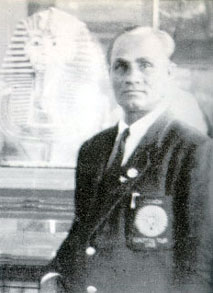The Suez Canal
The dues on a large vessel amount to £3,000 for each passage, which now takes about 12 to 15 hours. On an average, about 17 vessels per day pass through the Suez Canal, and of these, over 55% are under the British flag.
By Olympic Gold Medallist M. N. Masood
| Page 1 | Page 2 | Page 3 |
|
Page 4 | Page 5 | Page 6 |
The Suez Canal | By an international convention
signed in 1888, the Suez Canal was declared exempt from blockade, and warships
and merchant vessels of all nations are allowed to pass through both in times
of peace and war.
The dues on a large vessel amount to £3,000 for each passage, which now takes about 12 to 15 hours. On an average, about 17 vessels per day pass through the Suez Canal, and of these, over 55% are under the British flag. |
|||||
| Page 7 | Page 8 | Page 9 | Page 10 | Page 11 | Page 12 | |
![]() uez
was reached in the early hours of the July 6, and Port Said in the evening of
the same day. All day we sailed in the Suez Canal, which was a nice change after
the great expanses of the Arabian and the Red Seas.
uez
was reached in the early hours of the July 6, and Port Said in the evening of
the same day. All day we sailed in the Suez Canal, which was a nice change after
the great expanses of the Arabian and the Red Seas.
It may be interesting to the readers to know a little about this world-famous canal.
"About the middle of nineteenth century, Ferdinand de Lesseps commenced to advocate the scheme with great enthusiasm. After some time he succeeded in enlisting the support of the Khedive; and in 1856, the Suez Canal Company was formed.
Half the necessary capital was raised in France and half by the Khedive, who also provided labour for the work of excavation. The canal took over ten years to construct, and including development work to date, has cost £55,000,000. It was formally opened on November 17, 1869, by Empress Eugene.
In 1875, Disraeli bought for Great Britain the Khedive's shares, 176,602 out of a total of 400,000 for £4,000,000. These shares were valued in 1927 at £36,524,350.
By an international convention signed in 1888, the Suez Canal was declared exempt from blockade, and warships and merchant vessels of all nations are allowed to pass through both in times of peace and war.
The Suez Canal from Port Said to its junction with Suez Bay is 100 English miles. The width of the bed, originally 72 feet, is continually being increased and is nowhere less than 135 feet; it is being widened to a minimum width of 196 feet, and 250 feet in the bends. The depth throughout is now about 40 feet, and vessels of 33 feet draught are allowed to pass through.
There are 13 signal stations on the banks of the canal. The central local administration of the canal is located at Ismailia, where the exact position of each vessel is continuously indicated by a system of graphs, and orders are telegraphed to the signal stations. Preference is given to mail steamers, but wind conditions and tide frequently decide which vessel has to moor.
The speed of large vessels in the canal is limited to 6.5 nautical miles per hour. Only in the Great Bitter lake is a greater speed possible, owing to the larger area of water.
The canal dues on a larger vessel amount to £3,000 for each passage, which now takes about 12 to 15 hours. On an average, about 17 vessels per day pass through the Suez Canal, and of these, over 55% are under the British flag.
When the overland route for the mails to India was opened in 1842, Suez became a place of importance. Mails, passengers, stores and baggage were carried across the desert from Cairo; the P & O Company at one time owned 3000 camels thus employed, the passengers traveling in rough horse-drawn carriages. Afterwards came the railway and then the canal."
![]()

Dhyan Chand in Egypt
![]()